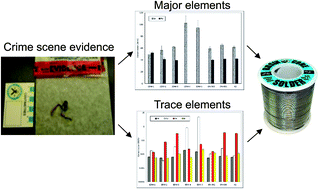Forensic analysis of lead–tin solder by inductively coupled plasma mass spectrometry†
Abstract
Lead–tin solder is commonly used in the making of improvised explosive devices (IEDs) and may be used to narrow down the list of suspects if pieces of solder salvaged at the crime scene can be matched to unused pieces found in a suspect's home. Using inductively coupled plasma mass spectrometry, the Ni, Cu, Sb and Bi trace impurities as well as the Pb and Sn major elements were quantified in lead–tin solders. Each 10 mg solder sample was fully digested in 2 mL of HNO3 and 0.5 mL of HCl with heating at 150 °C. Before dilution to 50 mL with high-purity water, 8 mL of HNO3 and 2 mL of HCl were added. Solutions were then diluted 1 : 100 for solder samples and 1 : 50 for the 99% Pb bullet standard reference material (SRM) that was used for day-to-day quality control. External calibration was performed using NIST SRM 1131, a 40 : 60 Sn : Pb solder SRM, digested and diluted like the samples. Distinguishable differences in the concentrations of major and trace elements were observed between eight different pieces of solder, which can help with identification in forensic cases. A heating gun with a copper soldering tip was also tested on two types of solder to see its effect on trace elemental concentrations. An increase in Cu concentration resulted for the solder sample with a rosin core, clearly indicating contamination. Such contamination may thus also provide information on the type of soldering gun used if the solder used to make the IED contained a rosin core.

- This article is part of the themed collection: JAAS 2018 Most Downloaded Articles


 Please wait while we load your content...
Please wait while we load your content...